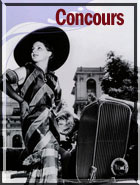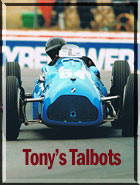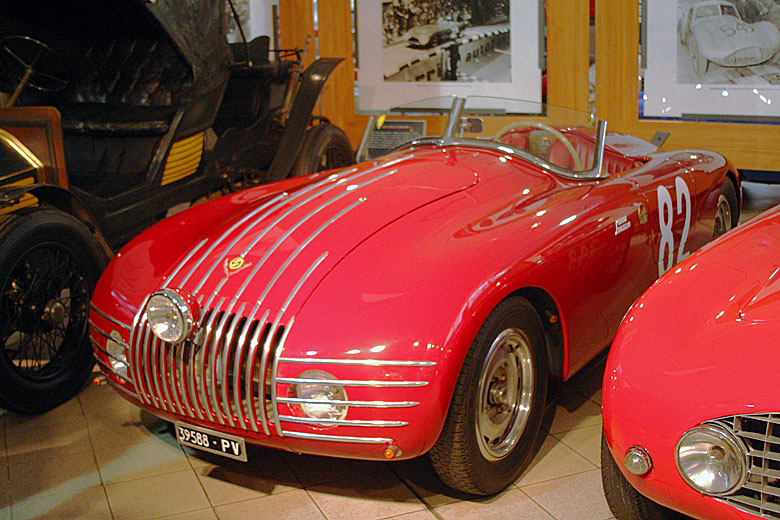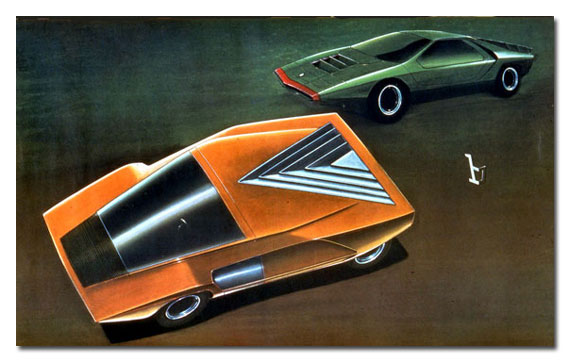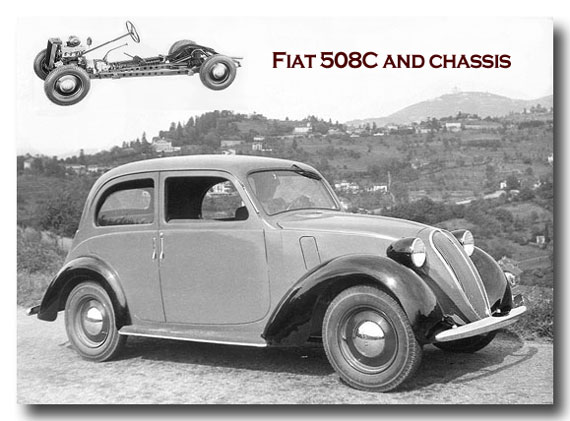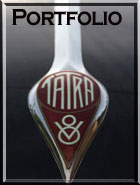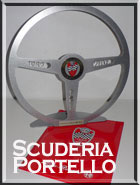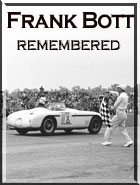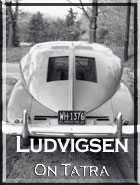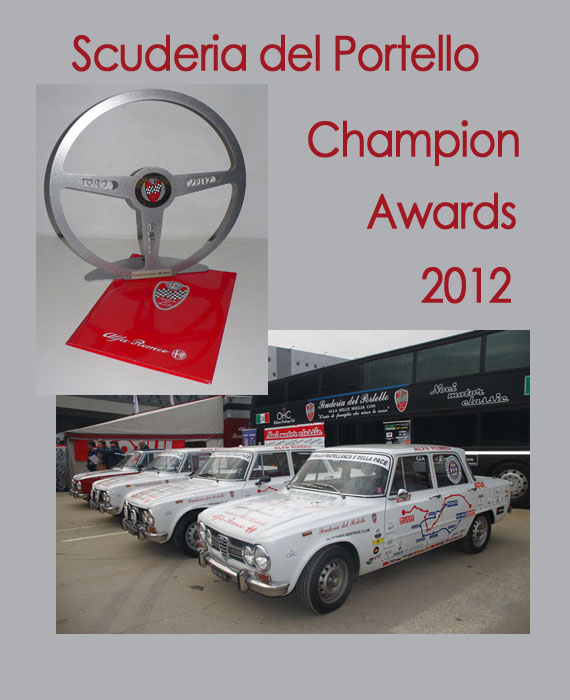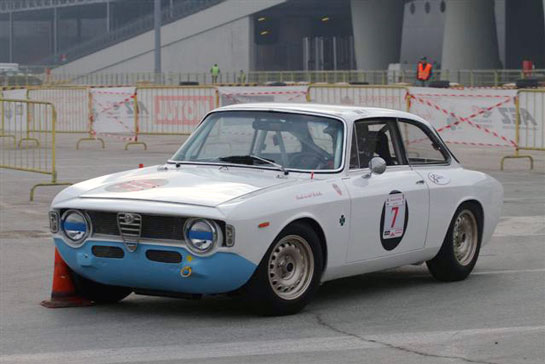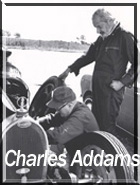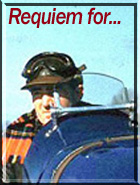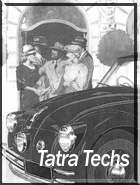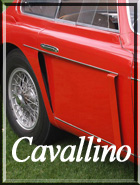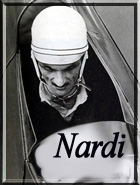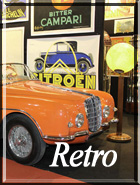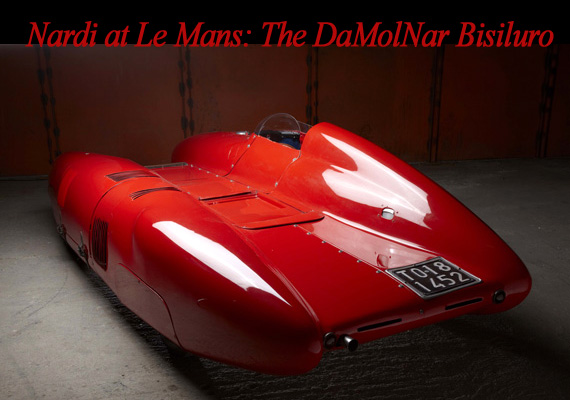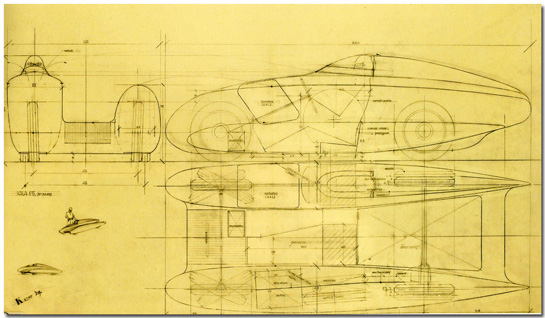Italian
More on the Ala d’Oro Stanguellini
Some time ago, reader Bill Spear emailed a photo taken from Life magazine back in the 1950s. We don’t know when or where the photo was taken but he had no idea what the car is or who built it. So of course he sent it to us. But after that was published, we hear more about this post war classic Stanguellini.
[Read more…] about More on the Ala d’Oro Stanguellini
Back to the Drawing Board
The recent introduction of the Bertone Nuccio and its obvious (and striking) connection with the 1970 Bertone Stratos caused our Italian Editor to recall driving the famed Lancia Stratos Zero (see last week’s article) but also to dig through his archives, where he found these remarkable drawings from the Archive Bertone. We now present them with the sketches of the new Nuccio for your pleasure.
Fiat 1100 Geburth
By Pete Vack and Alex Vazeos
Geburth Fiat Photos courtesy of Alex Vazeos
What about sending an Italian chassis out of Italy to have coachwork built? The normal direction would be to send your chassis to Italy where it would be given a fine set of new clothes by one of the famous carrozzerias that dotted the landscape in the 50s and 60s. It would be unique, well done, inexpensive and probably beautiful. A criss-cross, then, would involve having a chassis made in Italy bodied in some country not particularly known for automobiles and automobile design like Austria.
Italian chassis have been sent outward of their native land to be bodied and re-bodied for years, for example many pre-war Alfa Romeos were sent to the UK and bodied by James Young, Ranalah, or even more obscure firms such as Thornton. There was even a Ferrari 166 bodied by Abbot which did not last too long before being re-bodied again; another example was the couple of early Ferraris bodied by the Swiss firm of Ghia Aigle.
But still, such attempts go against the tide and in many cases were not very successful. Recently another such effort was uncovered in Austria, and therein lies our story…and as our resident car collector, Alex Vazeos, was quick to point out, “There couldn’t have been so many Austrian bodied Fiat 1100’s around so it might be worth a story”. We agreed.
The Fiat in question was a 1938 model, a simple 1089cc 508C four-door sedan, officially still called a “Balilla”, but the name was fading by then. The 508C was one of the most popular and successful Fiats to date, and over 250,000 were built between 1937 and 1939.
This 508C found its way to Austria, but the first ten years of its life are unknown, probably due to the war. It re-surfaced in November of 1948, when a Carl Rainer Harbach duly registered the car in the town of Pörtschach, famous for Johannes Brahms, who worked on his second symphony while staying in the tiny town, about 125Km from Venice. The next year it made its way to a new owner and location in Wein, a suburb of Vienna. After changing hands a few more times, on April 23 1955, it became the property of Dr. Oskar Göhring, the owner of a Heating-A/C firm by the name of Geburth-Kühlanlagen. Little did it know that it would be transformed, given a new life, and unlike most of the other 250,000 examples of 508Cs, be saved for posterity.
Our Features This Week, February 29th 2012
More Reasons to Subscribe to Our Premium Service
Below are only a few of the many subjects of our Premium articles available only to our Premium Subscribers. Please help support VeloceToday and our contributors by becoming a Premium Subscriber at one of three levels; $9.95 for one month, $7.95 per month for six months, or the best bet, $4.95 per month for one year ($59.40). Use the mediapass form found with each article to subscribe. If you need help, just email us at vack@cox.net.

Fast Ladies
Left, Miss Betty Haig and Mme Yvonne Simon, tuning their 2 liter Ferrari 166MM: one of many unpublished images from the book “Fast Ladies”. Dr. Patricia Lee Yongue not only describes this book but tells us about the lesser known women drivers featured in “Fast Ladies.”

Le Mitiche Sport a Bassano
What is Le Mitiche Sport a Bassano? Roughly, it means “Mythic Sport Cars in Bassano”. Bassano is more correctly Bassano del Grappa, and Grappa is a Brandy. It’s nice to have both an entrant and an organizer write the story of this delicious event in Italy. Only VeloceToday covers this wonderful event every year.

An Atlantic Reappears
Much of the breathless reportage in the business and popular press of the recent sale of a Type 57SC Bugatti Atlantic focused on its price and the supposed fact that there were only two — some said three – Atlantics built. So what’s the real deal?
Michael T. Lynch at his very best…only in VeloceToday

Beauty, Interrupted
The DeTomaso Mangusta is one of the most beautiful cars ever to come out of Italy. But it does have its problems, and we tell it like it is. This article really got our readers up in arms, both pro and con. The comments alone are worth the price of admission. By WallaceWyss
Subscribe Today!
Scuderia Portello Celebrates 30 Years with Honors
By Roberto Motta
Photos Scuderia del Portello
Italian version below
Milan – The Scuderia del Portello celebrated 30 years of sporting activities with the “Trophy of the Thirty Years” held in Milano on February 17 to 19th. The event was held at the new Fiera Milano, a 345,000 sq meter pavilion in conjunction with the “Milano Autoclassica”.
The celebration was attended by the Alfa Romeo race cars such as the GTA, GTAm, and Giulia, and Giulia GT sedans. The cars were challenged to participate in a circuit specially designed in the square in front of the pavilions of Nations Autoclassica. Eighteen GTA/GTAms were on hand and divided into two classes. The winner of the trophy for the GTA category was Jason Wright followed by Arturo Merzario, while in GTAm, Sabino de Castro and Francesco Frisone were first and second.
A large, passionate audience attended the exhibition of seven historic cars of the Carabinieri, and watched performances by go-karts and cars of every make.
Our Features This Week, February 22 2012
Subscribe Today to Access all of our Premium Articles
OSCA, Bugatti, Alfa Romeo, Nardi, Giovanni Savonuzzi, and Charles Addams are only a few of the many subjects of our Premium articles available only to our Premium Subscribers. Please help support VeloceToday and our contributors by becoming a Premium Subscriber at one of three levels; $9.95 for one month, $7.95 per month for six months, or the best bet, $4.95 per month for one year ($59.40). Use the mediapass form found with each article to subscribe. If you need help, just email us at vack@cox.net.
Charles Addams Series
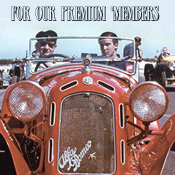 Charles Addams and his Cars 1948-1960
Charles Addams and his Cars 1948-1960
Charles Addams was a world famous cartoonist. Less well know was the fact that Addams had what he called a “long collection of rather good vintage cars,” which included two Bugattis, a 1933 Aston Martin, a supercharged Mercedes S, an Amilcar and the Castagna-bodied Alfa 2300. It was no passing fad; an interest sparked in 1948 at Indianapolis lasted forty years until his death at age 76 in 1988.
 Charles Addams and his Bugattis
Charles Addams and his Bugattis
In 1960, Charles Addams was beginning the most lucrative years of his career as a cartoonist. His income had almost tripled as the Addams Family was just making its TV debut. Finally, he would be now able to enjoy his Bugattis, to the distress of his neighbors. He competed with the Bugatti at VSCCA events at the old Bridgehampton racetrack near his home.
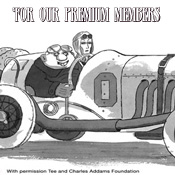 Charles Addams CAR toons
Charles Addams CAR toons
A consummate car enthusiast and creator of the “Addams Family”, Charles Addams could not resist putting cars into his cartoons. Here, with exclusive permissions from the Tee and Charles Addams Foundation, are some of Addams’ most interesting artwork incorporating his favorite hobby. The Charles Addams series can only be found in the pages of VeloceToday!
Renault’s Shooting Star
 Renault’s Shooting Star Part I
Renault’s Shooting Star Part I
The Bonneville Salt Flats, normally the home of monster records cars and big V-8 hot rods, played host to a tiny Renault streamliner in 1956. The car was small but established a big record of 190 miles per hour. Roberto Motta recounts the story of this remarkable turbine-powered car that won the hearts of Americans and international records at the same time.
 Renault’s Shooting Star Part II
Renault’s Shooting Star Part II
Once the engineers at Renault figured out how to shoehorn the turbine into a tiny one man chassis, they shipped the Renault Shooting Star off to America and the lonely Salts Flats in Utah. Roberto Motta, using rare factory color images, relates the record runs and wraps it up with the demonstrations at Montlhéry where Berhard Cahier drove the Shooting Star.
The Nardi Bisiluro Series
 Nardi at Le Mans
Nardi at Le Mans
The French Panhards and Renaults were dominating the small car classes at Le Mans in the post war era. Italians Enrico Nardi and Mario Damonte set about to challenge the French. Nardi created a new car with a Crosley engine and Motto body and trailered it to France. But it was just the opening act of Nardi at Le Mans. Here is the full story of the amazing Nardis at Le Mans.
 The Nardi Bisiluro
The Nardi Bisiluro
Undaunted by their 1954 experience at Le Mans, Nardi and Damonte brought in an eccentric artist and architect by the name of Carlo Mollino to design a streamlined body to compete at Le Mans. The results were startling. With the driver on one side and the engine on the other, the Bisiluro was one of the strangest cars ever to compete at Le Mans. Roberto Motta recounts the story.
OSCA 1600GT at Le Mans Series
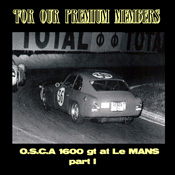 OSCA 1600GT at Le Mans Part I
OSCA 1600GT at Le Mans Part I
Part I deals with the team of John Gordon and John Bentley, whose exploits and successes at Le Mans and Sebring in a 750 cc OSCA led to the drive of an official OSCA factory entry at Le Mans. Their mount was the only flat-topped Zagato coupe, with a twin plug head and live rear axle. Co authored by Sebring Index winner John Gordon himself. Now available to all premium members.
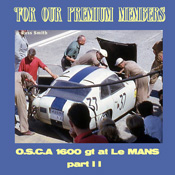 OSCA 1600GT at Le Mans Part II
OSCA 1600GT at Le Mans Part II
There were two OSCA 1600GT entries at Le Mans in 1962, s/n 0036, driven by Gordon and Bentley, and 007, entered by N.A.R.T. for Arents/Behra. Yet 007 appeared to be a very stock GT2 model, with IRS and a 108 hp single plug engine. We investigate these mysteries; relate what happened to the cars at Le Mans, and where they are now. Co authored by John Gordon.
The Saga of Giovanni Savonuzzi
From Showcar to Turbine
This first premium article deals with the Ghia Gilda, its history and restoration with full details of the installation of the turbine by as seen by Scott Grundfor in this exclusive interview. Written by Roberto Motta, the article includes rare diagrams, photos and inside views of the famous Ghia Gilda, designed by the great Giovanni Savonuzzi. “Gilda” sets the pace for the entire series on Savonuzzi.
Gilda, the Movie, the Star, the Inspiration
The second premium article, written by editor Pete Vack, explains the connection between the Ghia studios, the American movie of 1946 directed by Charles Vidor, and the impact of Rita Hayworth as the protagonist Gilda on both the movie and the designers of the era.
And did Savonuzzi really name his streamlined wonder Gilda? Find out.
The Cars of Giovanni Savonuzzi
In a stunning color portfolio by Hugues Vanhoolandt, we explore the Savonuzzi enigma: how does one man create the Cisitalia 202, most beautiful, iconic and legendary Italian car ever, and yet was also responsible for one of the most outrageous Prancing Horses ever built, the flying finned Ferrari 410 Superamerica. Along the way we highlight the Cisitalia Ford, the Nuvolari Spider, Nibbio II and much more.
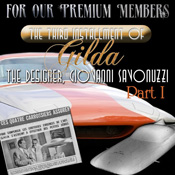 Savonuzzi, the Designer, Part I
Savonuzzi, the Designer, Part I
Giovanni Savonuzzi was a genius with the ability to be a superb stylist as well as an engineer. He was responsible for the Cisitalia Spider Nuvolari, the Cisitalia 202, the Ford 808XF project, the Ghia Gilda and record breaking motorboat engines. In Part 1, with the help of his daughter Alberta, we document his work at Cisitalia and SVA and why Pinin Farina got the credit for the Cisitalia 202.
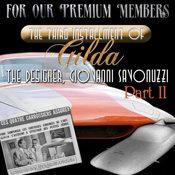 Savonuzzi, the Designer, Part II
Savonuzzi, the Designer, Part II
In Part II of Savonuzzi, the Designer takes us from Ghia to Chrysler, then on to Fiat. Never-before published documents and photos illustrate Savonuzzi’s role in the Ghia Chrysler Turbine and his fascinating American adventure. Written with the help of his daughter Alberta, Savonuzzi, the Designer describes his accomplishments and frustrations while at Chrysler.
Alfa Berlina Series
 Alfa Giulietta Berlina Portfolio
Alfa Giulietta Berlina Portfolio
Alfa’s 1300 Berlina is rarely seen outside the borders of Italy. In this portfolio, we’ve gathered up the best of show and factory images to present a variety of the Berlina station wagons, limos, special bodies and the standard sedans from the 1300 to the T.I. This is just one part of a series of four articles that cover the Berlina like never before. Only in VeloceToday!
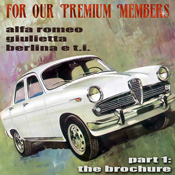 Alfa’s Giulietta Berlina
Alfa’s Giulietta Berlina
The Alfa Giulietta Berlina should have been the greatest sedan of the 1950s. We kick off a multi-part look at the semisweet success of Alfa’s first Giulietta, the Berlina, with a fascinating original brochure reproduced at 300 dpi. This is followed by a owners’ manual already available. Coming soon, the full history of the 1300 Berlina, variants, competition history and much more.
 Alfa Berlina, Italian Style
Alfa Berlina, Italian Style
VeloceToday’s Italian Editor Roberto Motta explains how the Alfa Giulietta Berlina won the hearts of Italians. “It was a car with a dual personality. Compact, aggressive and peaceful at the same time, the new family sedan was the ideal vehicle to transport children to school, while at the same time engage in competition on the weekends on track all over the world.” Written from the Italian perspective.
 Alfa Giulietta Berlina Manual
Alfa Giulietta Berlina Manual
Part of an in-depth series of Premium articles about the much-neglected Alfa Giulietta Berlina, this segment offers a rare look at a Alfa 1300 Berlina owner’s manual. The series also includes factory brochures, a full history, variants, and much more, all dedicated to what should have been the most advanced sporting saloon of the 1950s.
Our Features This Week, February 15th 2012
Nardi at Le Mans, Part 2: The Bisiluro
By Roberto Motta
Photos courtesty of Roberto Motta, Dino Brunori and Alessandro Nassiri © Archivio Museo Scienza
As we have seen, (Read Nardi at Le Mans Part I) despite the early retirement of his car in 1954, Damonte was still eager to compete with a Nardi at Le Mans. At some point in 1954, the engineer-architect, pilot and aircraft enthusiast Carlo Mollino was taken by the lines of Damonte Le Mans OSCA. Mollino had been hired by Damonte to redesign his personal apartment and the two shared an interest in cars. Using a photo of the OSCA as it appeared in a magazine, Mollino began to sketch out an idea for an aerodynamic body that would not cover a racing car chassis, but instead, a chassis would be constructed to conform to the streamlined body. Mollino became part of a new project to create a new car for the 1955 Le Mans. It would become known as the DaMolNar (Damonte/Mollino/Nardi Bisiluro.)
Mollino first designed a car with an aerodynamic nose, no radiator, modeling it like a thin airfoil and then began to add essential elements. The final design was a totally asymmetric car, consisting of two separate nacelles.* The left side contained the engine and transmission; the right side was dedicated and designed for a driver of small stature (less than 5 foot 7 inches).
[Read more…] about Nardi at Le Mans, Part 2: The BisiluroFerrari at Daytona, New F1: In English and Italian
By Roberto Motta
Photos courtesy of Media-Ferrari and Grand-Am Media
Daytona celebrated the 50th anniversary of the legendary International Speedway track in Florida with the Rolex 24 hour race held during the last weekend of January. The Grand Am Series kickoff saw the debut of the new Ferrari 458 Grand Am, the car is designed specifically for the Grand Am GT class. Based on Ferrari’s European GT3 racer, the new car turned its very first laps at the famous Daytona International Speedway in July of this year under the watchful and experienced eyes of both the manufacturer and its pre-eminent North American racing team, Risi Competizione.
[Read more…] about Ferrari at Daytona, New F1: In English and Italian


